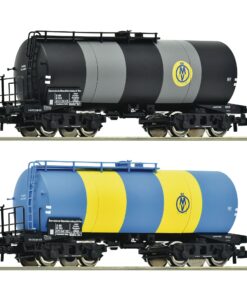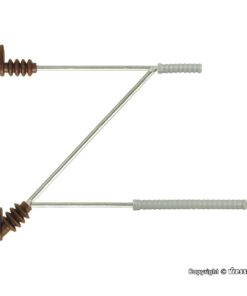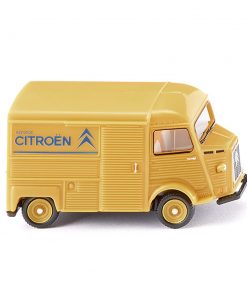-
×
 Kibri 38383
1 × 55,00 €
Kibri 38383
1 × 55,00 € -
×
 Wills SS74 - Pillbox
3 × 7,00 €
Wills SS74 - Pillbox
3 × 7,00 € -
×
 Tillig 76563
1 × 32,00 €
Tillig 76563
1 × 32,00 € -
×
 Wills SS75 - Halt, bus stop
1 × 8,00 €
Wills SS75 - Halt, bus stop
1 × 8,00 € -
×
 Markln 5112 M 1/2 Straight uncoupler track, used
1 × 25,00 €
Markln 5112 M 1/2 Straight uncoupler track, used
1 × 25,00 € -
×
 Roco 40501 AC pickup shoe 56mm
1 × 15,23 €
Roco 40501 AC pickup shoe 56mm
1 × 15,23 € -
×
 Kibri 38354
1 × 70,95 €
Kibri 38354
1 × 70,95 € -
×
 ModelCraft PFL-2211 File handle
1 × 7,00 €
ModelCraft PFL-2211 File handle
1 × 7,00 € -
×
 Busch 1047
2 × 18,70 €
Busch 1047
2 × 18,70 € -
×
 Kibri 38389
1 × 55,00 €
Kibri 38389
1 × 55,00 € -
×
 Woodland WC-1229 Earth Undercoat
2 × 15,95 €
Woodland WC-1229 Earth Undercoat
2 × 15,95 € -
×
 Kibri 36747 - Z scale Platform Friedrichstal
1 × 18,00 €
Kibri 36747 - Z scale Platform Friedrichstal
1 × 18,00 € -
×
 Wills SS44 - Fence
3 × 7,00 €
Wills SS44 - Fence
3 × 7,00 € -
×
 Noch 13030 - Field Fence
1 × 12,49 €
Noch 13030 - Field Fence
1 × 12,49 € -
×
 Kibri 38385
1 × 46,20 €
Kibri 38385
1 × 46,20 € -
×
 Wiking 023404 -Opel Manta B "Berlinetta" - orange
1 × 22,99 €
Wiking 023404 -Opel Manta B "Berlinetta" - orange
1 × 22,99 € -
×
 Heki 1957 - 20x trees, mixed forest
1 × 35,00 €
Heki 1957 - 20x trees, mixed forest
1 × 35,00 € -
×
 HobbyTrain - Zugspitzbahn valley locomotive with 2 passenger cars, epoch V, DC
1 × 429,90 €
HobbyTrain - Zugspitzbahn valley locomotive with 2 passenger cars, epoch V, DC
1 × 429,90 € -
×
 Viessmann 5062 - Level crossing railway warning signal
1 × 22,95 €
Viessmann 5062 - Level crossing railway warning signal
1 × 22,95 € -
×
 Kibri 39491
1 × 55,00 €
Kibri 39491
1 × 55,00 € -
×
 Kibri 38384
1 × 56,10 €
Kibri 38384
1 × 56,10 € -
×
 Kibri 39457
1 × 40,15 €
Kibri 39457
1 × 40,15 € -
×
 LS Models 32052 Belgian 4x freight set
1 × 160,00 €
LS Models 32052 Belgian 4x freight set
1 × 160,00 € -
×
 Wills SS73 - Timber yard
1 × 19,00 €
Wills SS73 - Timber yard
1 × 19,00 € -
×
 Wills SS50 - Wayside hut
2 × 9,00 €
Wills SS50 - Wayside hut
2 × 9,00 € -
×
 Brekina 58085 - Gräf & Stift 120 OGL, hellbeige/dunkelrot, Glockner Bus
1 × 35,00 €
Brekina 58085 - Gräf & Stift 120 OGL, hellbeige/dunkelrot, Glockner Bus
1 × 35,00 € -
×
 Viessmann 5039 - Taxi sign, lit
1 × 13,95 €
Viessmann 5039 - Taxi sign, lit
1 × 13,95 € -
×
 Deluxe Materials Scenic Rust
1 × 30,00 €
Deluxe Materials Scenic Rust
1 × 30,00 € -
×
 PECO SL-810 - Code200 metal Joiners
1 × 9,00 €
PECO SL-810 - Code200 metal Joiners
1 × 9,00 € -
×
 Roco 10002 Track cleaner
1 × 16,80 €
Roco 10002 Track cleaner
1 × 16,80 € -
×
 Heki 1819
1 × 10,60 €
Heki 1819
1 × 10,60 € -
×
 Kibri 38162
1 × 36,85 €
Kibri 38162
1 × 36,85 € -
×
 Viessmann 4114
1 × 16,95 €
Viessmann 4114
1 × 16,95 € -
×
 Auhagen 41700 - Narrow gauge railway set
1 × 35,00 €
Auhagen 41700 - Narrow gauge railway set
1 × 35,00 € -
×
 Preiser 17219 - Tables with tableclothes
1 × 15,29 €
Preiser 17219 - Tables with tableclothes
1 × 15,29 € -
×
 Roco 05417 - Postbus 120-ON
1 × 22,05 €
Roco 05417 - Postbus 120-ON
1 × 22,05 € -
×
 Roco BR57 rear lanterns set
1 × 8,40 €
Roco BR57 rear lanterns set
1 × 8,40 € -
×
 PECO SL-106F Code 75, Finescale, Bi-Block Sleeper
1 × 8,50 €
PECO SL-106F Code 75, Finescale, Bi-Block Sleeper
1 × 8,50 € -
×
 Markln 7041 – 3x aspect semaphore, Hp0/Hp1/Hp2, used
1 × 60,00 €
Markln 7041 – 3x aspect semaphore, Hp0/Hp1/Hp2, used
1 × 60,00 € -
×
 Vollmer 43525 Schonwies
1 × 36,95 €
Vollmer 43525 Schonwies
1 × 36,95 € -
×
 Markln 5108 M 1/4 Straight track, used
1 × 4,00 €
Markln 5108 M 1/4 Straight track, used
1 × 4,00 € -
×
 Auhagen 41701 - Narrow gauge railway track parts
1 × 12,00 €
Auhagen 41701 - Narrow gauge railway track parts
1 × 12,00 € -
×
 Kibri 38386
1 × 51,70 €
Kibri 38386
1 × 51,70 € -
×
 Kibri 48816
1 × 39,60 €
Kibri 48816
1 × 39,60 € -
×
 Kibri 38388
2 × 42,90 €
Kibri 38388
2 × 42,90 € -
×
 5203 Markln M Left Turnout, large lantern, used
1 × 28,00 €
5203 Markln M Left Turnout, large lantern, used
1 × 28,00 € -
×
 Wiking 088803 - Plough - green
1 × 6,99 €
Wiking 088803 - Plough - green
1 × 6,99 € -
×
 Seuthe Nr.10E - 10-16V
1 × 23,50 €
Seuthe Nr.10E - 10-16V
1 × 23,50 € -
×
 PIKO 55219 - R9, r=907,97mm
1 × 3,20 €
PIKO 55219 - R9, r=907,97mm
1 × 3,20 € -
×
 Kibri 18473 THW MB Actros Truck with Ronnenberg Trailer Kit
1 × 17,00 €
Kibri 18473 THW MB Actros Truck with Ronnenberg Trailer Kit
1 × 17,00 € -
×
 HACK BRUECKEN V15
1 × 19,00 €
HACK BRUECKEN V15
1 × 19,00 € -
×
 Heki 1801 - 100x 6mm grass tufts, summer
1 × 8,90 €
Heki 1801 - 100x 6mm grass tufts, summer
1 × 8,90 € -
×
 Wills SS52 - Retaining brick arcades
1 × 16,00 €
Wills SS52 - Retaining brick arcades
1 × 16,00 € -
×
 ESU 51970
1 × 40,00 €
ESU 51970
1 × 40,00 € -
×
 Wills SS65 - Toilets, WC
1 × 7,00 €
Wills SS65 - Toilets, WC
1 × 7,00 € -
×
 Weinert Modellbau 3373 - Bars kit
1 × 8,50 €
Weinert Modellbau 3373 - Bars kit
1 × 8,50 € -
×
 Ratio 506 - Water Tower
1 × 24,00 €
Ratio 506 - Water Tower
1 × 24,00 € -
×
 Vollmer 42080 - Alpine village set
1 × 74,80 €
Vollmer 42080 - Alpine village set
1 × 74,80 € -
×
 Faller 191729 - Power station
1 × 35,00 €
Faller 191729 - Power station
1 × 35,00 € -
×
 Roco 6600163 - 2 piece set: Tank wagons, ÖMV/ÖBB
1 × 82,90 €
Roco 6600163 - 2 piece set: Tank wagons, ÖMV/ÖBB
1 × 82,90 € -
×
 Busch 51704 - Nagetusch caravan, lilac-silver
1 × 20,00 €
Busch 51704 - Nagetusch caravan, lilac-silver
1 × 20,00 € -
×
 Tillig 76557
1 × 32,00 €
Tillig 76557
1 × 32,00 € -
×
 Kibri 39569
1 × 44,55 €
Kibri 39569
1 × 44,55 € -
×
 HACK BRUECKEN TP89-15
1 × 32,00 €
HACK BRUECKEN TP89-15
1 × 32,00 € -
×
 Roco 72369 OBB 1010, Sound
1 × 355,95 €
Roco 72369 OBB 1010, Sound
1 × 355,95 € -
×
 Viessmann 5095 - Traffic lights LED
1 × 57,50 €
Viessmann 5095 - Traffic lights LED
1 × 57,50 € -
×
alt_90x60-247x296.jpg) Kibri 38161
1 × 36,85 €
Kibri 38161
1 × 36,85 € -
×
 Fleischmann 6476 Roundhouse
2 × 125,90 €
Fleischmann 6476 Roundhouse
2 × 125,90 € -
×
 Woodland WBR -5034 Firehouse
1 × 120,00 €
Woodland WBR -5034 Firehouse
1 × 120,00 € -
×
 Piko SP20 - BR132 SKIRT
1 × 9,00 €
Piko SP20 - BR132 SKIRT
1 × 9,00 € -
×
 Viessmann 4531 - Semaphore signal, small mast, double coupled arm
1 × 75,95 €
Viessmann 4531 - Semaphore signal, small mast, double coupled arm
1 × 75,95 € -
×
 PECO SL110 - Rail joiners NikelSilver code75, code83
1 × 5,80 €
PECO SL110 - Rail joiners NikelSilver code75, code83
1 × 5,80 € -
×
 Evergreen - #219 White polystyrene rod 0,64mm
2 × 5,18 €
Evergreen - #219 White polystyrene rod 0,64mm
2 × 5,18 € -
×
 Wills SS36 - Dressed stone wall
1 × 7,00 €
Wills SS36 - Dressed stone wall
1 × 7,00 € -
×
 Wills SS-27 - Wayside station
1 × 9,00 €
Wills SS-27 - Wayside station
1 × 9,00 € -
×
 Liliput H0 L235970 VTG tank
1 × 42,00 €
Liliput H0 L235970 VTG tank
1 × 42,00 € -
×
 Viessmann 4168, Beam support, 5 pieces, short
1 × 15,95 €
Viessmann 4168, Beam support, 5 pieces, short
1 × 15,95 € -
×
 PECO SL-427 - H0e wagon turntable
1 × 5,00 €
PECO SL-427 - H0e wagon turntable
1 × 5,00 € -
×
 Ratio 508 - Boiler House
1 × 24,00 €
Ratio 508 - Boiler House
1 × 24,00 € -
×
 Kibri 39319
1 × 25,30 €
Kibri 39319
1 × 25,30 € -
×
 Railway design since 1830 - Vol2
1 × 40,00 €
Railway design since 1830 - Vol2
1 × 40,00 € -
×
 Woodland ST1413 4x 4% Ramps
1 × 16,95 €
Woodland ST1413 4x 4% Ramps
1 × 16,95 € -
×
 Noch 14361 - Garden Plot Shed
2 × 14,79 €
Noch 14361 - Garden Plot Shed
2 × 14,79 € -
×
 PECO SLE492 - H0e LH turnout, medium radius
1 × 25,00 €
PECO SLE492 - H0e LH turnout, medium radius
1 × 25,00 € -
×
 Kibri 38377
2 × 33,00 €
Kibri 38377
2 × 33,00 € -
×
 Tillig 76521
1 × 34,00 €
Tillig 76521
1 × 34,00 € -
×
 Kibri 48815
1 × 38,50 €
Kibri 48815
1 × 38,50 € -
×
 Busch 1208
1 × 8,50 €
Busch 1208
1 × 8,50 € -
×
 Woodland JP-5631 Arched Cast Iron Street Lights
1 × 34,95 €
Woodland JP-5631 Arched Cast Iron Street Lights
1 × 34,95 € -
×
 Woodland WC-1272 Coarse Buff Talus
1 × 7,95 €
Woodland WC-1272 Coarse Buff Talus
1 × 7,95 € -
×
 Woodland WC-1281 Extra Coarse Grey Talus
1 × 7,95 €
Woodland WC-1281 Extra Coarse Grey Talus
1 × 7,95 € -
×
 Faller 130451 - »Dold« butcher´s shop
1 × 55,00 €
Faller 130451 - »Dold« butcher´s shop
1 × 55,00 € -
×
 Liliput H0 L131401
1 × 290,00 €
Liliput H0 L131401
1 × 290,00 € -
×
 Evergreen - #210 White polystyrene rod 0,75mm
1 × 5,18 €
Evergreen - #210 White polystyrene rod 0,75mm
1 × 5,18 € -
×
 Wills SS41 - Fence
2 × 7,00 €
Wills SS41 - Fence
2 × 7,00 € -
×
 Colle 21 - Transparent dropper, single piece
1 × 0,40 €
Colle 21 - Transparent dropper, single piece
1 × 0,40 € -
×
 Heki 7241 -Plastic sheet 2mm
1 × 3,50 €
Heki 7241 -Plastic sheet 2mm
1 × 3,50 € -
×
 Marklin 7164 - Pickup shoe
1 × 6,29 €
Marklin 7164 - Pickup shoe
1 × 6,29 € -
×
 Piko 55471 - Bedding for right point WR, single
1 × 2,15 €
Piko 55471 - Bedding for right point WR, single
1 × 2,15 € -
×
 Viessmann 4173 - Tensioning pulleys
1 × 20,50 €
Viessmann 4173 - Tensioning pulleys
1 × 20,50 € -
×
 Tillig 76520
2 × 32,00 €
Tillig 76520
2 × 32,00 € -
×
 Brekina 61107 - AEC Routemaster
1 × 35,00 €
Brekina 61107 - AEC Routemaster
1 × 35,00 € -
×
 Noch 15223 - Passengers
1 × 16,99 €
Noch 15223 - Passengers
1 × 16,99 € -
×
 Viessmann 4558 - Marklin & Trix C track digital point motor
1 × 52,95 €
Viessmann 4558 - Marklin & Trix C track digital point motor
1 × 52,95 € -
×
 Kibri 39438 Loco shed
1 × 45,10 €
Kibri 39438 Loco shed
1 × 45,10 € -
×
 Busch 1423
1 × 66,00 €
Busch 1423
1 × 66,00 € -
×
 Faller 130238 - Church
1 × 38,00 €
Faller 130238 - Church
1 × 38,00 € -
×
 Kibri 16308 Robel wagon
1 × 33,95 €
Kibri 16308 Robel wagon
1 × 33,95 € -
×
 Piko 55470 - Bedding for left point WL, single
1 × 2,15 €
Piko 55470 - Bedding for left point WL, single
1 × 2,15 € -
×
 Busch 7416
1 × 2,00 €
Busch 7416
1 × 2,00 € -
×
 Preiser 10307 - Children swimming
1 × 14,20 €
Preiser 10307 - Children swimming
1 × 14,20 € -
×
 Roco tank wagon
1 × 18,90 €
Roco tank wagon
1 × 18,90 € -
×
 PIKO 55202 - Straight track, 119mm
1 × 2,20 €
PIKO 55202 - Straight track, 119mm
1 × 2,20 € -
×
 Deluxe Materials plastic putty
1 × 11,00 €
Deluxe Materials plastic putty
1 × 11,00 € -
×
 Liliput H0 L235497 Dujardin tank
1 × 48,00 €
Liliput H0 L235497 Dujardin tank
1 × 48,00 € -
×
 Tillig 76516
1 × 32,00 €
Tillig 76516
1 × 32,00 € -
×
 Woodland ST1422 - 6mm plate
1 × 12,95 €
Woodland ST1422 - 6mm plate
1 × 12,95 € -
×
 Woodland WTT-4582 Track painters - ties
1 × 11,95 €
Woodland WTT-4582 Track painters - ties
1 × 11,95 € -
×
 Faller 130448 - Town house »Allianz« + »Tea & Spices«
1 × 64,00 €
Faller 130448 - Town house »Allianz« + »Tea & Spices«
1 × 64,00 € -
×
 Woodland WTT-4580 Track painters Steel
1 × 11,95 €
Woodland WTT-4580 Track painters Steel
1 × 11,95 € -
×
 Fleischmann 6154 - Turntable set, 183mm
1 × 419,90 €
Fleischmann 6154 - Turntable set, 183mm
1 × 419,90 € -
×
 Auhagen 80716 - Walls 2390G, walls 2390H plastered
1 × 9,50 €
Auhagen 80716 - Walls 2390G, walls 2390H plastered
1 × 9,50 € -
×
 Wiking 026203 - Citroën HY panel truck "Citroën Service"
1 × 20,99 €
Wiking 026203 - Citroën HY panel truck "Citroën Service"
1 × 20,99 € -
×
 PECO SL-E387F - N scale Code55, Curved double radius L/H
1 × 28,00 €
PECO SL-E387F - N scale Code55, Curved double radius L/H
1 × 28,00 € -
×
 Colle 21 - Adhesive 21 spray 400ml
1 × 16,90 €
Colle 21 - Adhesive 21 spray 400ml
1 × 16,90 € -
×
 PIKO 55209 - Flexible Track 940 mm
1 × 7,00 €
PIKO 55209 - Flexible Track 940 mm
1 × 7,00 € -
×
 Evergreen - #268 White polystyrene channel 7,9mm
1 × 5,18 €
Evergreen - #268 White polystyrene channel 7,9mm
1 × 5,18 € -
×
 Νορβηγία - Ο σιδηρόδρομος Bergen-Oslo & Flam
1 × 24,00 €
Νορβηγία - Ο σιδηρόδρομος Bergen-Oslo & Flam
1 × 24,00 € -
×
 Preiser 16500 - Tank Crew
1 × 9,95 €
Preiser 16500 - Tank Crew
1 × 9,95 € -
×
 Preiser 18215
1 × 15,29 €
Preiser 18215
1 × 15,29 € -
×
 Busch 7415
1 × 2,00 €
Busch 7415
1 × 2,00 € -
×
 Deluxe Materials Ballast magic kit
1 × 20,00 €
Deluxe Materials Ballast magic kit
1 × 20,00 € -
×
 Kibri 39420 Coaling stage
1 × 48,95 €
Kibri 39420 Coaling stage
1 × 48,95 € -
×
 Seuthe Nr.28E - 10-16V
1 × 22,25 €
Seuthe Nr.28E - 10-16V
1 × 22,25 € -
×
 Evergreen - #230 White polystyrene tube 7,9mm O.Diameter
1 × 5,18 €
Evergreen - #230 White polystyrene tube 7,9mm O.Diameter
1 × 5,18 € -
×
 Woodland WA-1950 Rock n Roll dancers
1 × 19,00 €
Woodland WA-1950 Rock n Roll dancers
1 × 19,00 € -
×
 Auhagen 14465 - N scale, Farm
1 × 28,50 €
Auhagen 14465 - N scale, Farm
1 × 28,50 € -
×
 Marklin 73406 - Asymmetrical Pickup Shoe / Ground Spring Power Feed Set
1 × 11,99 €
Marklin 73406 - Asymmetrical Pickup Shoe / Ground Spring Power Feed Set
1 × 11,99 € -
×
 Woodland DPM 35600 - The Powerhouse, Scale Kit
1 × 86,00 €
Woodland DPM 35600 - The Powerhouse, Scale Kit
1 × 86,00 € -
×
 Seuthe Nr.9E - 8-14V
1 × 22,25 €
Seuthe Nr.9E - 8-14V
1 × 22,25 € -
×
 Liliput L939132 Close coupler mechanism
1 × 2,20 €
Liliput L939132 Close coupler mechanism
1 × 2,20 € -
×
 Artitec 10.170 Level Crossing
1 × 29,00 €
Artitec 10.170 Level Crossing
1 × 29,00 € -
×
 ModelCraft PDV-6713/3
1 × 5,50 €
ModelCraft PDV-6713/3
1 × 5,50 € -
×
 Woodland WC-1205 Flex Paste™
1 × 34,95 €
Woodland WC-1205 Flex Paste™
1 × 34,95 €
Υποσύνολο: 5.622,67 €

 English
English









